 |
| Number 53, November 2003 |
 |
| Crime scene fibers analyzed by new technique |
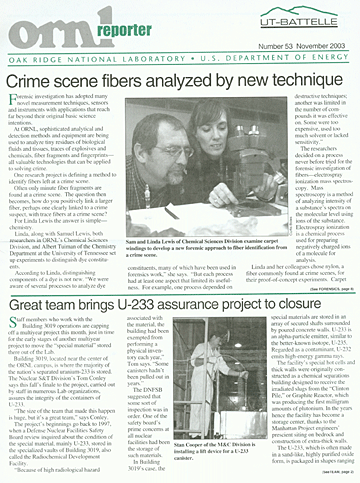 |
| Lab Notes |
|
|
|
|
|
|
|
|
|
|
|
|
|
|
Science writers come to ORNL to see Lab’s ‘cutting edge’ research |
|
 Crime scene fibers analyzed by new technique
Crime scene fibers analyzed by new technique
Forensic investigation has adopted many novel measurement techniques, sensors and instruments with applications that reach far beyond their original basic science intentions.
At ORNL, sophisticated analytical and detection methods and equipment are being used to analyze tiny residues of biological fluids and tissues, traces of explosives and chemicals, fiber fragments and fingerprints—all valuable technologies that can be applied to solving crime.
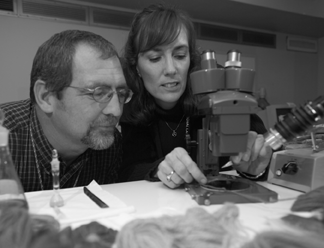 |
| Sam and Linda Lewis of Chemical Sciences Division examine carpet windings to develop a new forensic approach to fiber identification from a crime scene. |
One research project is defining a method to identify fibers left at a crime scene.
Often only minute fiber fragments are found at a crime scene. The question then becomes, how do you positively link a larger fiber, perhaps one clearly linked to a crime suspect, with trace fibers at a crime scene?
For Linda Lewis the answer is simple—chemistry.
Linda, along with Samuel Lewis, both researchers in ORNL’s Chemical Sciences Division, and Albert Tuiman of the Chemistry Department at the University of Tennessee set up experiments to distinguish dye constituents.
According to Linda, distinguishing components of a dye is not new. “We were aware of several processes to analyze dye constituents, many of which have been used in forensics work,” she says. “But each process had at least one aspect that limited its usefulness. For example, one process depended on destructive techniques; another was limited in the number of compounds it was effective on. Some were too expensive, used too much solvent or lacked sensitivity.”
The researchers decided on a process never before tried for the forensic investigation of fibers—electrospray ionization mass spectroscopy. Mass spectroscopy is a method of analyzing intensity of a substance’s spectra on the molecular level using ions of the substance. Electrospray ionization is a chemical process used for preparing negatively charged ions of a molecule for analysis.
Linda and her colleagues chose nylon, a fiber commonly found at crime scenes, for their proof-of-concept experiments. Carpet manufacturers supplied numerous colored carpet samples and colored nylon windings used in carpet manufacture. A chemical company supplied dyes used to color nylon carpets.
Nine dyes were examined in the initial study. At the beginning of their experiment, the researchers knew the chemical structure of only three from the scientific literature or from the manufacturer.
| The researchers determined that the chemical protocol they used was sufficient to make the comparison and that it was not necessary to apply other measures. |
Designing a protocol for determining the spectra of different dyes and the proportion of dye in each fiber was an important step, since the application to fiber dye was new. The researchers had a goal of using only a minute amount of fiber for a destructive dye analysis, which would leave the remainder of a sample for evidence.
They determined that they could measure and match dye components in samples as small as one millimeter. More importantly, the researchers also determined that the chemical protocol they used was sufficient to make the comparison and that it was not necessary to apply other measurement techniques such as separating the dye components by chromatography.
Additionally they determined that currently used forensic fiber dye methods are not sensitive enough to distinguish among different colored fabrics manufactured by a given company when computer dyeing techniques are used to mix the same dye components in slightly different ratios to produce similar colors, like olive green and brown.
The researchers acknowledge that their experiments were conducted using virgin windings and carpet samples and that normal use of the fibers—such as washing, drycleaning and exposure to sunlight and stains—might alter the dye content. However, in comparing a crime scene’s fiber fragment with a larger sample, both would have been subjected to the same normal use and the forensic comparison would still be valid.
The researchers hope to explore other fibers, including cotton, and various dyes. Linda says, “It’s rewarding to have an idea and see it work out so well. We’re hoping to improve our protocol and have this technique become a valuable addition to forensic investigation.”
Funding was provided by the FBI and materials assistance by Shaw Industries Inc., Collins and Aikman, and Ciba Specialty Chemicals.—Marty Goolsby
 Great team brings U-233 assurance project to closure
Great team brings U-233 assurance project to closure
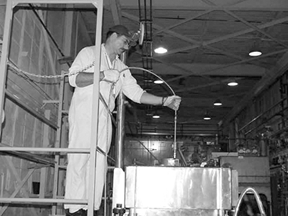 |
| Stan Cooper of the M&C Division is installing a lift device for a U-233 canister. |
Staff members who work with the Building 3019 operations are capping off a multiyear project this month, just in time for the early stages of another multiyear project to move the “special material” stored there out of the Lab.
Building 3019, located near the center of the ORNL campus, is where the majority of the nation’s separated uranium-233 is stored. The Nuclear S&T Division’s Tom Conley says this fall’s finale to the project, carried out by staff in numerous Lab organizations, assures the integrity of the containers of U-233.
“The size of the team that made this happen is huge, but it’s a great team,” says Conley.
The project’s beginnings go back to 1997, when a Defense Nuclear Facilities Safety Board review inquired about the condition of the special material, mainly U-233, stored in the specialized vaults of Building 3019, also called the Radiochemical Development Facility.
“Because of high radiological hazard associated with the material, the building had been exempted from performing a physical inventory each year,” Tom says. “Some canisters hadn’t been pulled out in years.”
The DNFSB suggested that some sort of inspection was in order. One of the safety board’s prime concerns at all nuclear facilities had been the storage of such materials.
In Building 3019’s case, the special materials are stored in an array of secured shafts surrounded by poured concrete walls. U-233 is an alpha-particle emitter, similar to the better-known isotope, U-235. Regarded as a contaminant, U-232 emits high-energy gamma rays.
The facility’s special hot cells and thick walls were originally constructed as a chemical separations building designed to receive the irradiated slugs from the “Clinton Pile,” or Graphite Reactor, which was producing the first milligram amounts of plutonium. In the years hence the facility has become a storage center, thanks to the Manhattan Project engineers’ prescient siting on bedrock and construction of extra-thick walls.
The U-233, which is often made in a sand-like, highly purified oxide form, is packaged in shapes ranging from rectangles to cylinders and inserted into other cylinders and then safely stored deep within the thick concrete. More than 1,000 packages are stored in the facility.
Inspecting the material, then, required expertise from across the Lab, including the Nonreactor Nuclear Facilities Division, which had the majority of staff involved. Also called on were the Quality Services Division, the Operational Safety Services Division along with security staff from Wackenhut.
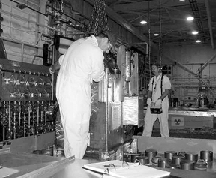 |
| Stan Cooper (left) and and Karl Thomas of Nonreactor Nuclear Facilities Division are installing the inspection chamber above the tube vault. |
After an operational readiness review, inspections began in 2001. Those inspections, since they had to be done remotely in a potentially extremely hazardous environment, required a considerable application of nuclear-material-handling technology.
“Building 3019 has seven concrete process cells,” Tom says. “The roof hatch of Cell 4 was converted into an array of 68 carbon-steel pipes encased in concrete. That’s where packages are stored for the most part.
“To inspect packages in a particular pipe or tube vault, we removed security devices, verified that the vault was properly ventilated, tested for hydrogen and stationed a ten-ton portable hot cell over the vault. The lead-lined, stainless steel portable cell allows fissile-material handlers to pull the package up into the cell while they are protected from the high radiation fields and from potential contamination.”
Once in the inspection chamber, the containers were visually inspected with remote cameras. Technicians verified the labeling, took measurements and did a smear test for contamination.
The container was then moved from the inspection container in a shielded transfer cask to a station where the gamma imaging, which gives an X-ray-like image of the contents of the container, was performed.
Fortunately, the staff were able to handle all the packages without encountering any actionable contamination. Tom says, “We’ve inspected 66 canisters per the requirements as a representative sample of the container types. We’ve also received a number of packages from Lawrence Livermore National Laboratory as part of the recommended consolidation—an inventory of odds and ends—plus we moved 22 sodium fluoride trap assemblies from the Molten Salt Reactor to 4501 for depressurization. So, in all, 131 packages were handled in the last two years, with no dropped cans and ALARA limits not even approached.”
ALARA refers to “as low as reasonably achievable” exposures to radiation.
Last month DOE announced the award of a contract to Isotek Systems, LLC, for the downblending of U-233 housed in the Building 3019 facility. The contract calls for the extraction of thorium-229 during the U-233 downblending process. The thorium will be used by Isotek’s partner, Theragenics, Inc., to extract actinium-225 and supply its daughter product, bismuth-213, for ongoing cancer research. The work will occur over an estimated nine-year period.
“We’re assured of the contents and integrity of the packages, and Isotek’s already on board,” says Tom. “A professional job all around.”—Bill Cabage
 ORNL people
ORNL people
The Biomedical Photonics Handbook, edited by Life Science’s Tuan Vo-Dinh, was recently published. The handbook brings together a wide variety of biomedical photonic technologies that have been developed for clinical monitoring of early disease states, molecular diagnostics and imaging of physiological parameters, molecular and genetic biomarkers and detection of the presence of pathological organisms or biochemical species of clinical performance. Tuan is a corporate fellow and group leader of the Advanced Biomedical Science and Technology group.
Dan Naus, Metals and Ceramics, has been elected a fellow of RILEM, “... in recognition of his exceptional scientific contribution to RILEM’s work.” RILEM is the French acronym for “International Union of Laboratories and Experts in Construction Materials, Systems and Structures.”
Lynn A. Boatner, Condensed Matter Sciences, and Hu F. Longmire, Metals and Ceramics, received 15th prize in the 2004 Nikon’s International Small World competition. They submitted a photomicrograph of the surface of titanium carbide crystal (64X) using differential interference contrast. Their photomicrograph appears in the Nikon Small World 2004 Calendar for August. The American Museum of Science and Energy will host the Nikon’s International Small World framed photomicrographs of the top 20 award winners June 28–July 18, 2004.
For the third time in three months, Life Science staffers have an item in the journal Nature. Lal Pinnaduwage, Anthony Gehl, Dave Hedden, Govindarajan Muralidharan, Thomas Thundat and other collaborators had the article, “A Microsensor for Trinitrotoluene Vapour,” published in the October 2 issue.
Dave Hamrin of the Office of Technical Information and Classification was elected chairperson of the DOE Contractor Classification Officers Conference for a two-year term. This group comprises the classification officers of all the DOE contractors, including the weapons labs.
 Chopper tests security tech
Chopper tests security techAircraft passing over the Lab aren’t an uncommon sight these days, but a helicopter overhead this month will be doing some especially interesting work. ORNL’s Nuclear S&T Division, working with the U.S. military, will test a Blackhawk helicopter equipped with radiation detection equipment as a proof-of-concept in detecting “illicit or unwanted radioactive material,” as principal investigator Fred Peretz describes.
“We’re testing a pair of commercial, off-the-shelf detectors in a common helicopter that most of the states have in their National Guard units,” says Fred. The concept, if it proves out, could be especially useful to authorities who have purview over shipyards and other likely avenues of illicit materials transport.
The Blackhawk, from the nearby McGhee Tyson Air Base, will make passes over the Experimental Gas-Cooled Reactor site, which will be arrayed with sealed gamma and neutron sources in different configurations to see if the detectors can pick them up. It’s a field test very similar to those for the Environmental Sciences Division’s helicopter-mounted unexploded ordnance detection systems described in Reporter 49.
The tests, slated for November 13–16, will include placing radiation sources in a field, in or near buildings and in a building that resembles the inside of a ship. Analysts on the ground will interpret data accumulated during the two-hour overflights.
 Benefits take a total approach
Benefits take a total approach
More than 1,000 staff members attended November 5’s Benefits Fair, held in the Research Office Building’s Main Street area. Main Street is becoming firmly established as the place to have an event, but ORNL Benefits’ slate of 50 vendors and more than a dozen speakers also accounted for the fair’s big crowd.
“The fair gives the Lab staff an opportunity to explore ways to be more savvy consumers with their benefits,” says Kathryn Cogar, Benefits’ communications spokesperson. “With health-care costs continuously rising everywhere, people need to be well-informed about their choices and options.”
Those choices go far beyond the staples of health care. Information booths ranged from educational assistance to wellness programs to financial planning. Sessions on retirement planning, in fact, were standing-room-only.
“Due to the demand, we’ll be asking our guest speaker to return for future sessions,” Kathryn says.
Rising benefit costs account for around half of the Lab’s rise in the cost of doing business, but the problem of spiraling health-care costs isn’t confined to ORNL. Jerry Burgess, CEO of HealthCare 21, keynoted the fair program with a discussion of how employers and employees can work together to deal with rising costs.
Kathryn notes that although the Lab’s open enrollment concludes this month, many of these programs are available to the staff year-round. If you missed the fair, Benefits’ newly revamped Website, home.ornl.gov/directorates/human_resources/Benefits, has tips on how to get more value per dollar with benefit programs.
 Parking: Fields of brown
Parking: Fields of brown
As anyone who drives a vehicle to ORNL will tell you, parking has become tight. The situation received some relief recently with the opening of a new lot at the corner of Central Avenue and Third Street. The lot provides about 50 spaces near the ORNL Cafeteria and Condensed Matter Sciences Division labs and offices.
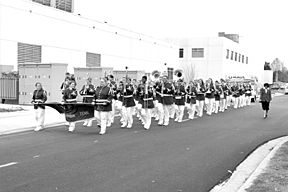 |
| Love a parade: Harriman High School’s excellent band played for the Lab’s Veterans Day ceremony on November 11. |
The site itself has a pretty interesting history. It’s the former South Tank Farm, where much of the Lab’s liquid radioactive waste from the Manhattan Project and shortly thereafter was stored. Most of the liquid waste was removed from the Gunite-coated tanks years ago, and the residual sludge was removed through a robot-assisted—and quite successful—Gunite and Associated Tanks Project completed by ORNL and Bechtel Jacobs staff three years ago.
The lot is now free of radiological hazards for staff routinely accessing it for parking, says ORNL Modernization Coordinator Lanny Bates. Some remaining underground waste lines and tanks in the area still require access controls, however, but they are clearly marked.
The new lot is an example of ORNL’s aim to put construction projects on “brownfield,” or previously used, locations, Lanny says, adding that more parking relief will come when another brownfield site (the holding ponds along Southside Drive that have already been filled in by Bechtel Jacobs) is capped and made ready for use in early 2004.
 20-year plan points the way
20-year plan points the way
Energy Secretary Spencer Abraham rolled out DOE’s 20-year facilities plan on November 10, and the prioritized wish list of 29 big projects contains some nice opportunities for ORNL.
Included are a second target station for the Spallation Neutron Source, as well as a power upgrade from 1 megawatt to 2-4 megawatts. The upgrade would double the number of experiments that can be conducted at the SNS, which is set to open for business in 2006. The plan also includes a second cold source for the High Flux Isotope Reactor, which would further bolster ORNL’s strength in neutron science.
ORNL’s new facilities, which include state-of-the-art space for the Lab’s supercomputers, position the Lab for a leading role in the Office of Science’s drive to regain the U.S. lead in high-performance computing, currently held by Japan’s Earth Simulator. Office of Science Director Ray Orbach described that mission in Reporter 41.
ORNL will make a strong pitch for the list’s Facility for Characterization and Imaging of Molecular Machines, which will develop new ways for scientists to understand protein complexes and cellular processes, says Chemical Sciences Division Director Michelle Buchanan. The facility would focus on microbes, which fits DOE’s missions in energy, environment and security.
The determination to put fusion-generated power on the grid sooner rather than later is reflected at the top of the list. ITER, the international fusion experiment the United States recently rejoined, is first on the list. Fusion Energy Division Director Stan Milora says ORNL, through its longstanding research in in plasma physics, engineering design, plasma fueling and heating technologies and fusion materials, and its collaboration with the Princeton Plasma Physics Laboratory, can be a major contributor to ITER and other fusion projects on the list.
ITER’s name, Stan notes, was derived from iter, which is Latin for “the way.”
| —Reported by Bill Cabage |
 Science writers come to ORNL to see Lab’s ‘cutting edge’ research
Science writers come to ORNL to see Lab’s ‘cutting edge’ research
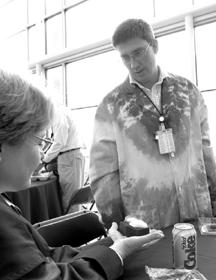 |
| Metals and Ceramics Division researcher James Klett demonstrates the heat-conducting properties of carbon foam to a CASW participant who is melting ice placed on the foam with the heat of her hands. |
Eight ORNL researchers were among the star presenters at the Council for the Advancement of Science Writing’s 2003 New Horizons Briefing, held in late October in Oak Ridge and Knoxville.
The Laboratory and the University of Tennessee co-hosted the annual event, which brings together distinguished scientists from a host of disciplines to meet with science writers and other journalists from a variety of media outlets. The briefing explores developments in science, medicine and technology that are likely to make news in the coming months.
CASW, founded in 1959, develops and funds programs to help newspaper, magazine and television reporters and editors, universities, and corporations present accurate, reliable and informative news stories to the public about developments in science and medicine. It offers aid to students who wish to follow a career in science reporting and also works to improve relations between science reporters and scientists.
Nearly 200 persons participated in this year’s five-day program, which included formal program presentations from 18 scientists and professors from leading research institutions across the country. Special events included an afternoon tour of ORNL, welcome reception at the UT president’s residence, awards dinner at the Knoxville Convention Center, and barbecue and bluegrass party at the Museum of Appalachia in Norris.
On the ORNL campus the writers visited the Aquatics Research Center, the Science Exploratorium and the Spallation Neutron Source site. They also saw a demonstration of the heat-conducting properties of graphite foam.
Laboratory Director Jeff Wadsworth, who welcomed the group to ORNL, said later, “The fact that the conference came to Oak Ridge speaks volumes about the reputation of our scientific research. I am extremely proud of those who made presentations and of the great staff who made the visit a success. We should reap benefits from this event for years to come.”
Representatives from the following media outlets attended the briefing: Knight-Ridder, American Scientist, Science Magazine, Popular Science, WGBH (Boston)/NOVA, Newsday, U.S. News & World Report, The Washington Post, Dallas Morning News, CNN, Toronto Star, Christian Science Monitor and The Wall Street Journal.
Local coverage of the event appeared on WBIR-TV (NBC affiliate), WATE-TV (ABC affiliate), WVLT-TV (CBS affiliate) and in the Oak Ridger.
Here are summaries of the presentations by ORNL researchers.
Michelle Buchanan, Chemical Sciences Division Director, “Beyond Proteomics: Defining the ‘Machines of Life.’”
Seldom do proteins in living cells act alone. Rather, they combine to form multi-protein complexes; it is these aggregates that bear responsibility for the vast repertoire of tasks—growth, metabolism, replication, repair, intra- and intercellular signaling—required to nurture and sustain life. Researchers have very limited knowledge of these ensembles, largely because proteins are generally isolated and studied on an individual basis. But a large, multidisciplinary effort is beginning to change all that. In the pilot phase, the team is working with two bacterial species to evaluate newly minted technologies for “pulling down” distinct, intact complexes (thought to number in the thousands in these model microorganisms) and for determining the contents and dynamics of each of these “machines of life” and how they interact with each other under varying environmental conditions. One goal among many: using this newly gained protein-complex wisdom to develop tailor-made therapies against complex—multigenic—diseases.
Michael Simpson, distinguished R&D staff member, Engineering and Science Technology Division, “Engineering Signal Intelligence Into Cells.”
Efforts are under way to convert genetically engineered microorganisms, bacteria and yeast, nested in carbon nanotube-laced silicon chips, into executive decision-makers with the power to regulate their surroundings and in the process perform such beneficial functions as waste treatment, disease diagnosis and perhaps cell-based computation.
Thomas Thundat, distinguished staff scientist, Life Sciences Division, “The Cantilevered MEMS Chip.”
Custom-crafted to fix chosen chemical targets, ultra-tiny, chiseled-in-silicon cantilevers—miniscule “diving boards” that bend in response to the capture of nanoparticles—open the way to a slew of applications. To wit: forensic searches; detection of chemical and biological agents of terror; as retinal prostheses; and as implants to assess the effectiveness of hip and knee replacements.
Michael Ramsey, corporate research fellow, Chemical Sciences Division, “Nanofluidics and the Artificial Cell.”
New developments in the ability to manipulate fluids transiting through channels of the smallest possible dimensions lay the groundwork for, among other things, the creation of receptor-flecked artificial cells capable of spotting hazardous environmental agents; screening compounds for their potential as drugs; and sequencing of DNA at rates many orders of magnitude faster than currently possible.
François Pin, corporate fellow and group leader, Robotics and Engineering Machines Group, Engineering Science and Technology Division, “Wearable Robotics.”
The images—of a woefully fatigued U.S. solider, savaged by the blistering Iraqi desert sun, struggling to get to his feet from a kneel-rest position under the weight of his 125-pound backpack—make a lasting impression. Now, picture this: same solider, same conditions, only this time he’s up in a trice, all but indifferent to the fact that he is bearing such a heavy load. What makes the difference? The exoskeleton, a wearable machine that’s able to sense the intent of limb movement and to amplify strength. Although not quite yet here, the day of the “Superman Suit” is rapidly approaching, a consequence of recent advances in a slew of enabling technologies, ranging from compact power sources and power-dense actuators to advanced body-sensing methodologies and computational capabilities. For now, the developmental focus is on easing the infantryman’s plight so as to significantly increase endurance and mobility. Eventually, exoskeletons will be put to work benefiting others, including the elderly and handicapped; patients needing physical rehabilitation; and assembly line, construction and rescue workers.
Thom Mason, associate Laboratory director, Spallation Neutron Source, and Geoffrey Greene, research scientist in the Physics Division, “The Spallation Neutron Source.”
When the Spallation Neutron Source—the nation’s largest science project—a comes on line in 2006, atop an 80-acre site on the Oak Ridge National Laboratory campus, the $1.4 billion, accelerator-based facility will generate pulsed neutron beams with up to 10 times more intensity than any other source in the world. As such, the SNS, with its 24 leading-edge, neutron-scattering instruments, will enable researchers to add immeasurably to their understanding of the fundamental properties of materials knowledge to be used in developing more powerful magnets; high-temperature superconductors; more effective medications; and lighter, stronger structural elements. It is also expected to help nuclear scientists answer some basic, as yet unresolved questions about the neutron itself. When completed, the SNS will annually serve an estimated 2,000 chemists, physicists, biologists, geologists and engineers from the U.S. and abroad.
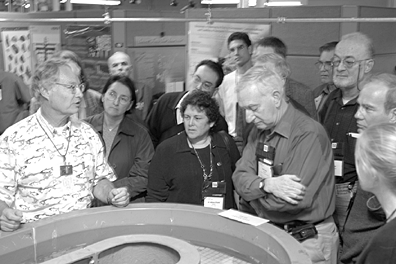 |
| During a site tour Life Sciences researcher Chuck Coutant explains a project to determine the effects of sound, whether natural or man-made, on fish. The LDRD-funded project, which includes both native fish and migrating fish, is being conducted in the Aquatics Laboratory. |
Arpad Vass, research scientist, Life Sciences Division, “Interpreting All That Remains: New Data, New Insights.”
Hallowed as they may be to journalism (at least its old-school practitioners), the five w’s are absolutely indispensable to crime-scene investigations. More often than not, the toughest question to resolve is when—when did the victim die. Current technologies can pinpoint the time of death to within two days for soft-tissue decay and two weeks for skeletonized remains up to about five years. But newly discovered biomarkers, stemming from investigations at the Body Farm, the one-of-a-kind UT forensic facility, could narrow the estimated range to less than 12 hours. The chemical composition of decay odor is being parsed as a first step towards developing hand-held devices for determining the post-mortem interval but also for locating clandestine graves. The skeletonized remains derived from the Body Farm, meanwhile, have been yielding information that is adding immeasurably to the database used by forensic experts worldwide to match the age, sex and ethnicity of skeletal finds. The newest edition of the Web-accessible resource is about to be released.—Cindy Lundy
 Volunteers needed for Lego League
Volunteers needed for Lego League
UT-Battelle is co-sponsoring the 4th Annual Tennessee FIRST LEGO® League state tournament. The all-day event will be held on December 6 on the campus of Tennessee Technological University in Cookeville. Event organizers say that FIRST LEGO League presents an interactive program that captivates kids’ interest in science and technology as they master the dynamics of teamwork and problem solving.
Each fall, FLL announces its “Challenge,” which highlights a current scientific or chronological problem facing the world. During the Challenge process, teams of children (ages 9-14) have 8 weeks to build, program and test their own fully autonomous robot capable of completing various table-top “missions.”
The team must take on specific roles and responsibilities in order to accomplish the Challenge in time. This year the FLL Challenge is entitled “Mission Mars” and highlights the questions that NASA is considering with their own current Mars exploration mission.
Organizers of the event are recruiting volunteers to interview the team members and make awards for best Robot Design, Research Presentation, Teamwork and Team Spirit. They’re looking especially for any person with a special knowledge of Mars or a relationship to the current NASA mission to serve as a Research Presentation Judge. Organizers say that this event also gives children the opportunity to meet science and technical role models that go beyond rock stars and sports personalities.
If you would like to know more about this program, visit the website at firstlegoleague.org. If you would like to volunteer to be a judge contact Brad Weil at 574-7147 or weilbs@ornl.gov.
 Toxicologist in sheep’s clothing
Toxicologist in sheep’s clothing
Carol Wood assesses health risk of chemicals
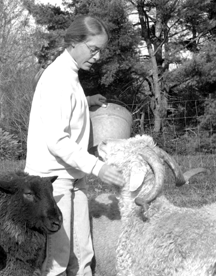 |
| Carol Wood surrounded by some of her sources of wool. |
During part of the day you might find Carol Wood at her computer analyzing data to determine the risk of chemicals to human health. During another part of the day you might find her with a bucket of grain in hand on a mission to feed her llamas, goats, sheep and alpaca. Or you might find her sitting at her spinning wheel magically spinning raw wool from her animals into yarn or flashing knitting needles as she fashions the yarn into sweaters.
By profession Carol is a toxicologist in the Life Sciences Division. She analyzes data collected from experiments with laboratory animals and human volunteers for the effects of chemicals on developmental and reproductive health. She also extrapolates the animal-collected data to assess general human health risk.
To prepare for this work she majored in biochemistry at Mississippi State University where she received a bachelor’s degree. “I have always been interested in how cells function and how that function contributes to the well being of the organism. The biochemistry curriculum at MSU covered those sorts of things,” Carol says.
During her senior year, a professor teaching advanced cell physiology suggested graduate studies in toxicology. That led to a master’s degree in biology from MSU with a special study on the metabolism of organophosphate insecticides by various tissues.
After growing up in Hernando, Miss., she moved to the West Coast to study toxicology at Oregon State University for her doctorate, with a dissertation on the birth defects induced in cattle by a plant alkaloid.
Shortly after her doctoral program she met Bob Ross, who heads ORNL’s Toxicology and Hazard Assessment group, at a professional meeting. He interviewed her, and she joined the ORNL staff in 1994. She became a board-certified toxicologist in 1997.
Much of Carol’s work is on the toxicity evaluation of pesticides, which is required by the Environmental Protection Agency on a regular basis. The EPA registration of pesticides is an ongoing process. Federal law requires that before a pesticide is sold or distributed it must be registered. A new pesticide must undergo more than 100 different scientific studies and tests before it can be registered. “A pesticide has to be tested for potential developmental, reproductive, nervous system and many other health effects,” Carol says, “before EPA will approve it for use.” For pesticides that may be used on food or feed crops, EPA also sets tolerances for the amount of the pesticide that can legally remain in or on foods.
Carol and others at ORNL also work with the National Advisory Committee for Acute Exposure Guideline Levels (AEGLs), which are developed to help emergency planners in case of an accident involving chemicals. One of her recent publications dealt with AEGLs for methyl isocyanate, a chemical that made history in 1984 because of a release from a chemical plant in Bhopal, India. Although human volunteer studies were not conducted, a number of case reports have been collected from Bhopal survivors and MIC-exposed workers. They found instances of higher spontaneous abortion rates and infant death rates in women who were pregnant when exposed.
“No one wants to see another Bhopal. We hope the AEGL process will help avoid that,” she says. Industrial workers consistently note skin and respiratory irritation when exposed.
Another AEGL assessment Carol has done – with the chemicals 2,4-toluene diisocyanate and 2,6-toluene diisocyanate – will be presented with her colleagues next spring at the Society of Toxicology’s annual meeting.
TDI is used in the manufacture of polyurenthane products and causes irritation and sensitization of the respiratory tract. In addition to animal studies, human volunteers who were asthmatic were also included in some of the studies. Although the studies did not detect changes in lung function, several of the volunteers reported symptoms that included eye and throat irritation, cough, chest tightness, runny nose, shortness of breath and headache.
In addition to pesticides and AEGLs, Carol has worked on toxicity evaluations of chemical warfare agents, high production volume chemicals, and endocrine disruptors.
For her move to Tennessee, she bought a small farm in Harriman. On the way to her job at the Lab, she visited friends in Minnesota. “My interest in spinning,” Carol says, “started with my friend in Minnesota who taught me how to spin. I’ve always liked animals,” she continues, “so raising animals to produce wool was just a natural next step for me and my farm.”
“When the yarn started accumulating, I decided to do something with it. I took lessons in Oak Ridge and began knitting, mostly gifts,” she says.
Carol and her husband Scott own 11 acres in Roane County that they share with three cats, 10 sheep, three angora goats, two llamas, one alpaca and two guard dogs. A local spinner shears the animals to harvest the raw fiber for Carol. Then Carol either spins the fibers for her knitting projects or sells the raw fiber to other spinners.
“I have no aspirations to have a commercial enterprise. I do this just because I enjoy it,” she says.—Marty Goolsby
 LEGO League presents challenges, opportunities
LEGO League presents challenges, opportunities
UT-Battelle is co-sponsoring the 4th Annual Tennessee FIRST LEGO® League state tournament. The all-day event will be held on December 6 on the campus of Tennessee Technological University in Cookeville. Event organizers say that FIRST LEGO League presents an interactive program that captivates kids’ interest in science and technology as they master the dynamics of teamwork and problem solving.
Each fall, FLL announces its “challenge,” which highlights a current scientific or chronological problem facing the world. During the challenge process, teams of children (ages 9-14) have 8 weeks to build, program and test their own fully autonomous robot capable of completing various table-top “missions.” The team must take on specific roles and responsibilities in order to accomplish the challenge in time. This year the FLL challenge is entitled “Mission Mars” and highlights the questions that NASA is considering with their own current Mars exploration mission.
Organizers of the event are recruiting volunteers to interview the team members and make awards for best robot design, research presentation, teamwork and team spirit. They’re looking especially for any person with a special knowledge of Mars or a relationship to the current NASA mission to serve as a research presentation judge. Organizers say that this event also gives children the opportunity to meet science and technical role models that go beyond rock stars and sports personalities.
If you would like to know more about this program, visit the Website at firstlegoleague.org. If you would like to volunteer to be a judge contact Brad Weil at 574-7147.
 Energy program proves its worth
Energy program proves its worth
Do all those taxpayer dollars spent to achieve greater energy efficiency really save anything? Marty Schweitzer and a group of Oak Ridge National Laboratory researchers recently completed an analysis to determine the cost versus the benefits of the DOE’s State Energy Program and had interesting results.
Originally conceived to count program activities, the ORNL study was later expanded to calculate energy and cost savings and emissions reductions as well.
All states, territories and the District of Columbia were contacted and asked to provide their individual data in the program areas defined by the researchers. Among the 20 program areas were energy audits, loans and grants, codes and standards, workshops/training, building retrofits and traffic signals.
Twenty states responded including the three most populous—California, Texas and New York—and the least populous, Wyoming. Together, the 20 states represent 46 percent of all funds allocated through DOE’s State Energy Program or SEP, and almost half of the U.S. population.
According to Schweitzer, there is much more emphasis today in the federal government than even a few years ago on evaluation. “What were they (SEP) saving in terms of energy and costs? DOE wanted to know and asked us to do the first systematic measurement of the program outcomes. After determining a set of enumerator indicators to measure the actions taken, we developed multipliers to calculate energy and cost savings and emissions reductions,” said Schweitzer.
The SEP is difficult to evaluate because it has a lot of elements and variations. Some program elements are mandatory but many elements the states can choose for themselves. Because there is flexibility built into the overall program, different states do different things with different emphases. “It is difficult to say what has been accomplished without such measurement,” Schweitzer said.
Funds for the actions carried out under the State Energy Program come directly from DOE as well as from other federal programs, the states themselves and the private sector. “Our research indicates that the DOE money leverages quite a bit from other sources.” Schweitzer said an example might be an utility company that contributes to an energy audit effort to help reduce its needed generating capacity.
In DOE’s SEP certain elements are mandatory from state to state, such as establishing lighting efficiency standards. Optional elements might include audits or integrated energy plans. With the flexibility that DOE offers, a state can design a plan that fits its needs and submit it to DOE. Basically two kinds of funds come to the states through SEP – allocations based on population and special projects.
In conducting the study, Schweitzer said. “First, we had to classify the activities. We came up with 20 different program areas that made sense to us. We looked at program areas that cut across the energy-use sectors. We also decided on things we wouldn’t do, like separate types of fuel.”
Then the researchers determined enumerator indicators to count activities. When the sponsor asked that the researchers also calculate how much energy was being saved through the SEP, they made adjustments in the study methods.
“It’s tough,” Schweitzer said, “to take activity estimates and calculate savings. So we did an intensive literature search of studies from sources such as universities, states and utilities that had been done to quantify energy savings. We used these to put together multipliers to tell how much energy is saved for a single action of a particular type. Of the 20 program areas we had chosen, we determined that only 14 could be quantified at that time.
Schweitzer said, “In the responding states, we calculated that 1.17 million source BTUs and $7.23 were saved annually for each dollar of SEP funds spent on programs for which savings could be quantified.” Emissions reductions for carbon, sulfur dioxide, nitrogen oxide and several other substances were also calculated.
Schweitzer also pointed out that the SEP produces security-related and economic benefits not included in the study. “If we were able to place a full monetary value on all non-energy benefits and found new indicators for some of the unquantified program areas, it’s likely that the cost savings and emissions reductions would be considerably higher,” he said.
With the experience of the first study behind them, the researchers have entered a new phase. Currently they are designing a study with new indicators that would require less data collection on the part of the states while covering even more program areas. They are also considering a study to assess the non-energy benefits of the program, such as energy security and economic well-being, which were not the focus of the first study.—Marty Goolsby
 New Hires
New Hires
Kenneth Gray and Randy Haese, Business & Information Services
Clark Piercy, Networking & Computing Technologies
Robert Silvia and Jeffrey Vetter, Computer Science & Mathematics
Jana Traver, Environmental Sciences
 Time to submit 2004 R&D 100 nominations
Time to submit 2004 R&D 100 nominations
It’s only been a few weeks since ORNL researchers received four R&D 100 awards at ceremonies in Chicago, but it’s time to begin work on the 2004 awards nominations.
ORNL has been very successful in the history of the awards from R&D Magazine, which since 1963 has given the awards for the 100 most significant innovations of the year. ORNL’s total of 116 awards is second only to General Electric.
General instructions, a new form and tips on “How to Win an R&D 100 Award” are available at the honors and awards website, www.ornl.gov/info/awards/honors_awards.htm
Honors and awards manger, Phil King, kingpwiii@ornl.gov, needs the following if you are interested in submitting a nomination.
- The name(s) of the developer(s) of the technology,
- The name of a secretary or administrative person with whom the Honors and Awards Office and the editor will be working, and
- The name of the technology.
First drafts of nominations are due to editor, Walter Koncinski by Friday, December 19. For details regarding the rest of the schedule, contact Phil King at 574-9618 or Walter Koncinski at 574-6958.
 2004 UT-Battelle scholarship applications due January14
2004 UT-Battelle scholarship applications due January14
January 14 is the deadline for submitting an application for the 2004 UT-Battelle Scholarship. The award goes annually to a child of a UT-Battelle employee. The renewable scholarship to the University of Tennessee-Knoxville is aimed at encouraging careers in science. It is granted on a competitive basis.
The scholarship is worth $4,000 per academic year and is renewable for four years if the student maintains full-time enrollment, a strong grade-point average and steady progress toward a baccalaureate degree.
Students may select a major course of study leading to a baccalaureate degree offered through UT in science, engineering or mathematics. In addition, UT-Battelle scholars will spend at least one practicum term at ORNL. Applicants must meet the following eligibility criteria, which parallel those for UT’s Bicentennial Scholarship Program:
- Son or daughter of a current UT-Battelle employee
- High school diploma held by the end of the current school year
- Resident of Tennessee
- Acceptance to the University of Tennessee-Knoxville for the following fall term>
- Minimum high school grade point average of 3.75 in a 4.0 system and an ACT test score of 31
The application form is available on the science education website at www.ornl.gov/ornlhome/education.shtml Completed applications and reference material should to sent to Gail Beyersdorf, 4500N, MS-6266.
ORNL office: P.O. Box 2008, Oak Ridge, TN 37831-6146, Building 4500-S, Room F-60, MS 6146
DOE inspector general hotline: 1-800-541-1625
[an error occurred while processing this directive]
[an error occurred while processing this directive]
Marty Goolsby, lead editor, ORNL, 865/574-4166 (goolsbymb@ornl.gov)
Deborah Barnes, associate editor, 865/576-0470 (barnesds@ornl.gov)
